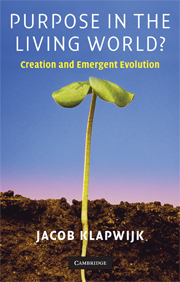Book contents
- Frontmatter
- Contents
- List of figures
- Preface
- Introduction
- 1 Does life on earth have a purpose?
- 2 Creationism, Intelligent Design, and Augustine's idea of time
- 3 Darwin, neo-Darwinism, and the naturalistic continuity claim
- 4 Miller's pre-biotic broth and the premises of evolutionism
- 5 A cold shudder along Darwin's back
- 6 The emergence theory of Morgan and Alexander
- 7 Luctor et emergo: what is emergent evolution?
- 8 Toward a general theory of emergent evolution
- 9 Hominization and the philosophy of mind
- 10 Augustinian faith and evolutionary science
- 11 The organism is a whole. The world is a habitat
- 12 The slumbering temptation of essentialism
- 13 Questions surrounding the emergence process
- 14 Enkapsis in nature. Is there an Omega point?
- Bibliography
- Index
5 - A cold shudder along Darwin's back
Published online by Cambridge University Press: 05 June 2012
- Frontmatter
- Contents
- List of figures
- Preface
- Introduction
- 1 Does life on earth have a purpose?
- 2 Creationism, Intelligent Design, and Augustine's idea of time
- 3 Darwin, neo-Darwinism, and the naturalistic continuity claim
- 4 Miller's pre-biotic broth and the premises of evolutionism
- 5 A cold shudder along Darwin's back
- 6 The emergence theory of Morgan and Alexander
- 7 Luctor et emergo: what is emergent evolution?
- 8 Toward a general theory of emergent evolution
- 9 Hominization and the philosophy of mind
- 10 Augustinian faith and evolutionary science
- 11 The organism is a whole. The world is a habitat
- 12 The slumbering temptation of essentialism
- 13 Questions surrounding the emergence process
- 14 Enkapsis in nature. Is there an Omega point?
- Bibliography
- Index
Summary
The great challenges of modern evolution theory do not lie in the bumptious claims of radical evolutionary naturalists but in the painstaking proofs that empirical investigators have brought to the table. It is these proofs that have made the traditional theory of the constancy of species extremely unlikely. First there are the fossil finds, slowly surrendered by the soil. Despite numerous fissures and disturbancies of the earth's crust these fossils testify, from layer to layer, to the reality of evolutionary change. Then there are the morphological differences between closely related, yet isolated populations, first observed by Darwin in the finches and giant tortoises in the Galápagos archipelago. Furthermore, there are the structural similarities between homologous body parts, such as the bones of the wings of birds and the front legs of mammals, even when these body parts now have different functions. Finally, there are the remarkable parallels between the phases of development through which an embryo goes, and the phylogenetic development that species have undergone, even if Ernst H. Haeckel's “biogenetic law” has, in general, been abandoned. All these phenomena suggest evolutionary change and a common origin of all life forms.
But there is even more! Nowadays the idea of phylogenetic relationship and common ancestry receives a strong support from the laboratory observations of biochemists and molecular biologists. Biochemists have found that when inorganic compounds are exposed to sparks in a chamber, the resulting amino acids are a racemic mixture.
- Type
- Chapter
- Information
- Purpose in the Living World?Creation and Emergent Evolution, pp. 71 - 89Publisher: Cambridge University PressPrint publication year: 2008

